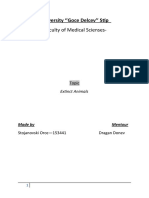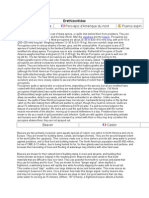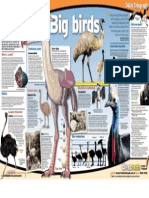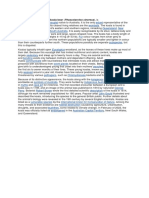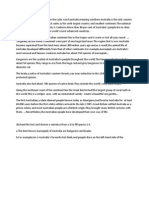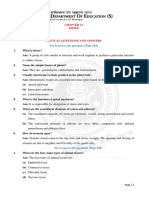Paragraph
Paragraph
Uploaded by
yune22032009Copyright:
Available Formats
Paragraph
Paragraph
Uploaded by
yune22032009Copyright
Available Formats
Share this document
Did you find this document useful?
Is this content inappropriate?
Copyright:
Available Formats
Paragraph
Paragraph
Uploaded by
yune22032009Copyright:
Available Formats
The dingo debate
Graziers see them as pests, and poisoning is common, but some biologists
think Australia’s dingoes are the best weapon in a war against imported cats
and foxes.
A A plane flies a slow pattern over Carlton Hill station, a 3,600 square
kilometre ranch in the Kimberley region in northwest Australia. As the plane
circles, those aboard drop 1,000 small pieces of meat, one by one, onto the
scrubland below, each piece laced with poison; this practice is known as
baiting.
Besides 50,000 head of cattle, Carlton Hill is home to the dingo, Australia’s
largest mammalian predator and the bane of a grazier's (cattle farmer's) life.
Stuart McKechnie, manager of Carlton Hill, complains that graziers’
livelihoods are threatened when dingoes prey on cattle. But one man wants
the baiting to end, and for dingoes to once again roam Australia’s wide-open
spaces. According to Chris Johnson of James Cook University, ‘Australia
needs more dingoes to protect our biodiversity.’
B About 4,000 years ago, Asian sailors introduced dingoes to Australia.
Throughout the ensuing millennia, these descendants of the wolf spread
across the continent and, as the Tasmanian tiger disappeared completely
from Australia, dingoes became Australia’s top predators. As agricultural
development took place, the European settlers found that they could not
safely keep their livestock where dingoes roamed. So began one of the most
sustained efforts at pest control in Australia’s history. Over the last 150
years, dingoes have been shot and poisoned, and fences have been used in an
attempt to keep them away from livestock. But at the same time, as the
European settlers tried to eliminate one native pest from Australia, they
introduced more of their own.
C In 1860, the rabbit was unleashed on Australia by a wealthy landowner
and by 1980 rabbits had covered most of the mainland. Rabbits provide huge
prey base for two other introduced species: the feral (wild) cat and the red
fox.
The Interaction between foxes, cats and rabbits is a huge problem for native
mammals. In good years, rabbit numbers increase dramatically, and fox and
cat populations grow quickly in response to the abundance of this prey.
When bad seasons follow, rabbit numbers are significantly reduced - and the
dwindling but still large fox and cat populations are left with little to eat
besides native mammals.
D Australian mammals generally reproduce much more slowly than rabbits,
cats and foxes - and adaption to prevent overpopulation in the arid
environment, where food can be scarce and unreliable - and populations
decline because they can’t grow fast enough to replace animals killed by the
predators. Johnson says dingoes are the solution to this problem because
they keep cat and fox populations under control. Besides regularly eating the
smaller predators, dingoes will kill them simply to lessen competition.
Dingo packs live in large, stable territories and generally have only one
fertile, which limits their rate of increase. In the 4,000 years that dingoes
have been Australia, they have contributed to few, if any, extinctions,
Johnsons says.
E Reaching out from a desolate spot where three states meet, for 2,500 km
in either direction, is the world’s longest fence, two metres high and
stretching from the coast in Queensland to the Great Australian Bight in
South Australia; it is there to keep dingoes out of southeast, the fence
separates the main types of livestock found in Australia. To the northwest of
the fence, cattle predominate; to the southwest, sheep fill the landscape. In
fact, Australia is a land dominated by these animals - 25 million cattle, 100
million sheep and just over 20 million people.
F While there is no argument that dingoes will prey on sheep if given the
chance, they don’t hunt cattle once the calves are much past two or three
weeks old, according to McKechnie. And a study in Queensland suggests
that dingoes don’t even prey heavily on the newborn calves unless their
staple prey disappears due to deteriorating conditions like drought.
You might also like
- ELLT Reading Test 2 PDFDocument2 pagesELLT Reading Test 2 PDFBrijbala JainNo ratings yet
- Koala Fact Sheet: StatusDocument2 pagesKoala Fact Sheet: StatusRaul RoncallaNo ratings yet
- Reading - The Dingo DebateDocument4 pagesReading - The Dingo DebateTrân BùiNo ratings yet
- CHUYÊN ĐỀ 31Document3 pagesCHUYÊN ĐỀ 31ngọc linhNo ratings yet
- IELTS Reading Practice 1 2024 AprilDocument15 pagesIELTS Reading Practice 1 2024 Aprilthanhthaolt24No ratings yet
- The Dingo DebateDocument5 pagesThe Dingo DebateTháiTửQuangHuyNo ratings yet
- Lesson 8Document6 pagesLesson 8xoshimovamohira85No ratings yet
- Faculty of Medical Scienses-: University 'Goce Delcev'' StipDocument8 pagesFaculty of Medical Scienses-: University 'Goce Delcev'' StipStojance IlievskiNo ratings yet
- Animal ExtinctionsDocument8 pagesAnimal ExtinctionsKanishkNo ratings yet
- Extinct AnimalsDocument13 pagesExtinct AnimalsIyliahNo ratings yet
- Ielts Academic Reading Practice Test123Document3 pagesIelts Academic Reading Practice Test123goldstardtmgoldstarNo ratings yet
- Extinct AnimalsDocument6 pagesExtinct Animalsthasarathanr1993_939No ratings yet
- US Food Waste Worth More Than Offshore DrillingDocument9 pagesUS Food Waste Worth More Than Offshore DrillingarpitchugghNo ratings yet
- Ielts y N NG PracticeDocument4 pagesIelts y N NG PracticeBitan BanerjeeNo ratings yet
- Isle Royale ArticleDocument1 pageIsle Royale Articleapi-277207237No ratings yet
- Animals in DangerDocument11 pagesAnimals in DangerBojana MihajlovaNo ratings yet
- North American Porcupine Porc-Épic D'amérique Du Nord Puerco EspínDocument6 pagesNorth American Porcupine Porc-Épic D'amérique Du Nord Puerco EspínitsankurzNo ratings yet
- The Wild Animals of AustraliaDocument3 pagesThe Wild Animals of Australiachenvc5285No ratings yet
- Virgil Lesane-Research PaperDocument7 pagesVirgil Lesane-Research PaperVirgil LesaneNo ratings yet
- Would You Like Him On Your Salad? Why Not?Document11 pagesWould You Like Him On Your Salad? Why Not?bumblebee9323No ratings yet
- Gray Wolf Biology Questions and Answers: 1) Why Was The Gray Wolf Listed As Endangered?Document7 pagesGray Wolf Biology Questions and Answers: 1) Why Was The Gray Wolf Listed As Endangered?Mukesh BadrinathNo ratings yet
- Extinct AnimalsDocument4 pagesExtinct AnimalsAmit MartinNo ratings yet
- Source: 1. 2.: 1. Giant PandaDocument2 pagesSource: 1. 2.: 1. Giant PandachetanNo ratings yet
- OTTERSDocument6 pagesOTTERSMiguel LleraNo ratings yet
- Endangered Species Eatherback Sea Turtle: SourceDocument4 pagesEndangered Species Eatherback Sea Turtle: SourcechetanNo ratings yet
- Animals of AustraliaDocument5 pagesAnimals of AustraliaShabs Zujer PatlaNo ratings yet
- Big Birds PDFDocument1 pageBig Birds PDFatulNo ratings yet
- T (Felis: EcologyDocument2 pagesT (Felis: EcologydavemikemcNo ratings yet
- 10 Extinc AnimalsDocument10 pages10 Extinc AnimalsJASPER REYESNo ratings yet
- Eight Extinct Animals: ( The Year of Extinction)Document8 pagesEight Extinct Animals: ( The Year of Extinction)NADINE TULALESSYNo ratings yet
- Reading Practice Cambridge 17 Test 3Document13 pagesReading Practice Cambridge 17 Test 3sidikNo ratings yet
- Endangered SpeciesDocument2 pagesEndangered SpeciesspiritusNo ratings yet
- The Ferals that Ate Australia: The fascinating history of feral animals and winner of a 2022 Whitley Award from the bestselling author of The Dogs that Made AustraliaFrom EverandThe Ferals that Ate Australia: The fascinating history of feral animals and winner of a 2022 Whitley Award from the bestselling author of The Dogs that Made AustraliaRating: 5 out of 5 stars5/5 (1)
- The Great Australian FenceDocument5 pagesThe Great Australian FenceAnNo ratings yet
- Savremeni Engleski JezikDocument11 pagesSavremeni Engleski JezikFatima MujčićNo ratings yet
- The Feral Cat (Felis Catus) : History EcologyDocument3 pagesThe Feral Cat (Felis Catus) : History Ecologyapi-279811261No ratings yet
- Endangered Species - Tasmanian Devils Return To Mainland AustraliaDocument3 pagesEndangered Species - Tasmanian Devils Return To Mainland Australiacarmanlao2No ratings yet
- Endangerd AnimalsDocument2 pagesEndangerd AnimalsCandy KittyNo ratings yet
- 14 Jan Beasts UKMAPDocument1 page14 Jan Beasts UKMAPThe IndependentNo ratings yet
- Apes in The News Wild Beavers Seen in England For First Time in CenturiesDocument3 pagesApes in The News Wild Beavers Seen in England For First Time in Centuriesapi-250807061No ratings yet
- IPA Fox PA13 PDFDocument4 pagesIPA Fox PA13 PDFColumbia GomezNo ratings yet
- 10 Most Ammasing Extinct AnimalsDocument7 pages10 Most Ammasing Extinct AnimalsVishal PandeyNo ratings yet
- Final Main TextDocument2 pagesFinal Main TextCedric EscobiaNo ratings yet
- AbcdefghDocument1 pageAbcdefghscNo ratings yet
- Animals of North America For Kids: Amazing Animal Books for Young ReadersFrom EverandAnimals of North America For Kids: Amazing Animal Books for Young ReadersRating: 5 out of 5 stars5/5 (2)
- Article About Death of LolongDocument2 pagesArticle About Death of LolongJosephine GraceNo ratings yet
- Contoh Report Text 2Document2 pagesContoh Report Text 2salajar007No ratings yet
- Aniamls in DangerDocument12 pagesAniamls in DangerGisselle AlemánNo ratings yet
- 45-Wildlife Co3serva123tion EffortsDocument184 pages45-Wildlife Co3serva123tion EffortsdevNo ratings yet
- Flora and Fauna of AustraliaDocument2 pagesFlora and Fauna of AustraliaJoseph Darren P. LacanlaleNo ratings yet
- Feral GoatDocument4 pagesFeral Goatapi-279811261No ratings yet
- Vol 1test 9 RealieltsexamDocument7 pagesVol 1test 9 RealieltsexamĐoàn Ngọc Yến NhiNo ratings yet
- Cats in New ZelandDocument4 pagesCats in New ZelandAdelaNo ratings yet
- Elusive, Obscure, and Eclipsed in Popularity by Their Larger Cousins, Small Cats Are Amazing, High-Performance PredatorsDocument5 pagesElusive, Obscure, and Eclipsed in Popularity by Their Larger Cousins, Small Cats Are Amazing, High-Performance PredatorsVildana NeslanovićNo ratings yet
- The Name Australia Comes From The Latin Word AustralisDocument1 pageThe Name Australia Comes From The Latin Word AustralisAlexandra MadalinaNo ratings yet
- GhirottoGuadanucci 2021 Sexual Behavior Diplura IschnotheleDocument14 pagesGhirottoGuadanucci 2021 Sexual Behavior Diplura IschnotheleCarlos Mauricio RamirezNo ratings yet
- ... Latihan SoalDocument8 pages... Latihan SoalAqillatul HusnaNo ratings yet
- Bio Exp 2 Hanis HaidaDocument10 pagesBio Exp 2 Hanis HaidaӇⱭӀƊⱭ ƘӇⱭlӀՏƳⱭ ՏƲƑƳⱭNo ratings yet
- Endangered Species in SloveniaDocument2 pagesEndangered Species in SloveniaNELA TURINNo ratings yet
- Asgn 5974128103Document7 pagesAsgn 5974128103rappycatNo ratings yet
- SY2022 2023 Q2 G4 ScienceDocument6 pagesSY2022 2023 Q2 G4 Sciencemcescentral matinaNo ratings yet
- ANATOMICAL STUDY OF ANOMALY STRUCTURE IN CucurbitaDocument5 pagesANATOMICAL STUDY OF ANOMALY STRUCTURE IN CucurbitaGaluh Novita Ayu0% (1)
- Lesson 2 - Muscular SystemDocument7 pagesLesson 2 - Muscular SystemCherubim GimaranganNo ratings yet
- Effect of Different Season On The Life Cycle of Dannus Chrysippus (L.) (Plain Tiger)Document3 pagesEffect of Different Season On The Life Cycle of Dannus Chrysippus (L.) (Plain Tiger)International Journal of Innovative Science and Research TechnologyNo ratings yet
- History of AnimalsDocument15 pagesHistory of Animalscmacharia598No ratings yet
- Cell Parts and Their FunctionsDocument9 pagesCell Parts and Their FunctionsMlshin LaoNo ratings yet
- ScienceDocument3 pagesScienceCoffee RistrettoNo ratings yet
- CKSci G5U6 Human-Hormones-and-Reproduction SRDocument54 pagesCKSci G5U6 Human-Hormones-and-Reproduction SRGlenn ClementeNo ratings yet
- The Digestive System Graphic OrganiserDocument1 pageThe Digestive System Graphic Organiserapi-350307578100% (1)
- Ujian 1 Biologi Form 4Document12 pagesUjian 1 Biologi Form 4edain84No ratings yet
- BiodiversityDocument32 pagesBiodiversityNorliyana Ali100% (1)
- AnusDocument11 pagesAnusPrateek SinghNo ratings yet
- SeriPaperIII PDFDocument100 pagesSeriPaperIII PDFMonuNo ratings yet
- Trilaminar Germ DiscDocument18 pagesTrilaminar Germ DiscPapadoveNo ratings yet
- Histology of GitDocument56 pagesHistology of GitDoc On CallNo ratings yet
- Bs 2nd Lec 5Document3 pagesBs 2nd Lec 5rimshabashir950No ratings yet
- Lecture 2 - HomeostasisDocument27 pagesLecture 2 - HomeostasisAndre Luis CostaNo ratings yet
- LYNNYL Gaming: Axie Infinity: Class GuideDocument46 pagesLYNNYL Gaming: Axie Infinity: Class GuideAyorius XNo ratings yet
- LAB EXAM Systems ReviewerDocument5 pagesLAB EXAM Systems ReviewerAlexandra Danielle LimjocoNo ratings yet
- 4 - TissueDocument13 pages4 - TissueGel Austin PascuaNo ratings yet
- Integumentary SystemDocument21 pagesIntegumentary SystemGiester Mae DadiosNo ratings yet
- Activity 5 Frog DissectionDocument11 pagesActivity 5 Frog DissectionJohn PagangpangNo ratings yet
- ComprehensionDocument12 pagesComprehensionSharadNo ratings yet
- Tissue Solutions Textual Questions and Answers: Is Called A TissueDocument11 pagesTissue Solutions Textual Questions and Answers: Is Called A TissueMr Pan GamingNo ratings yet
- Lab 1 - Plant Cells and TissuesDocument8 pagesLab 1 - Plant Cells and TissuesArushiSoodNo ratings yet







